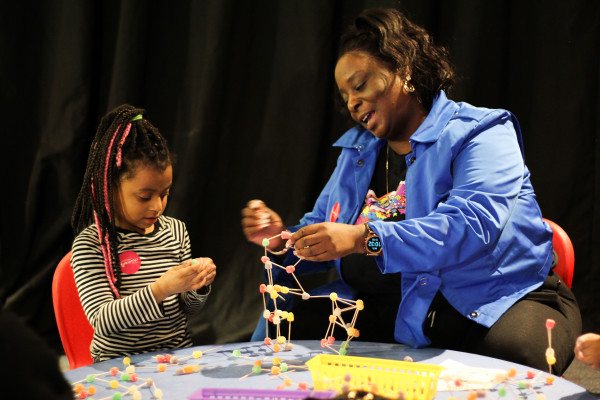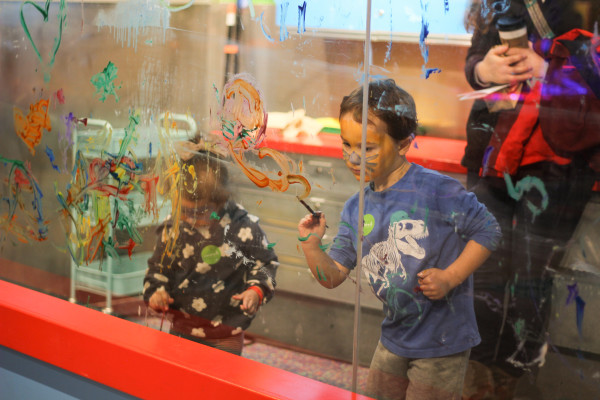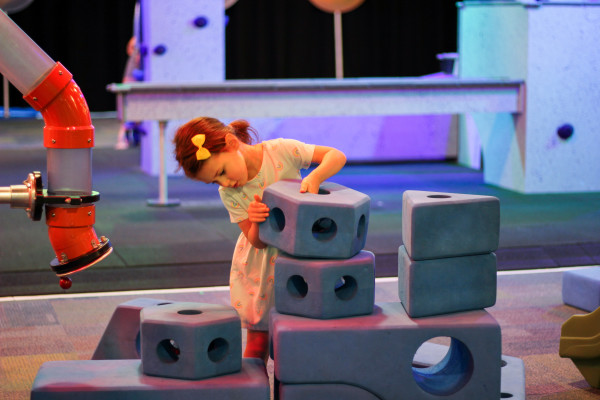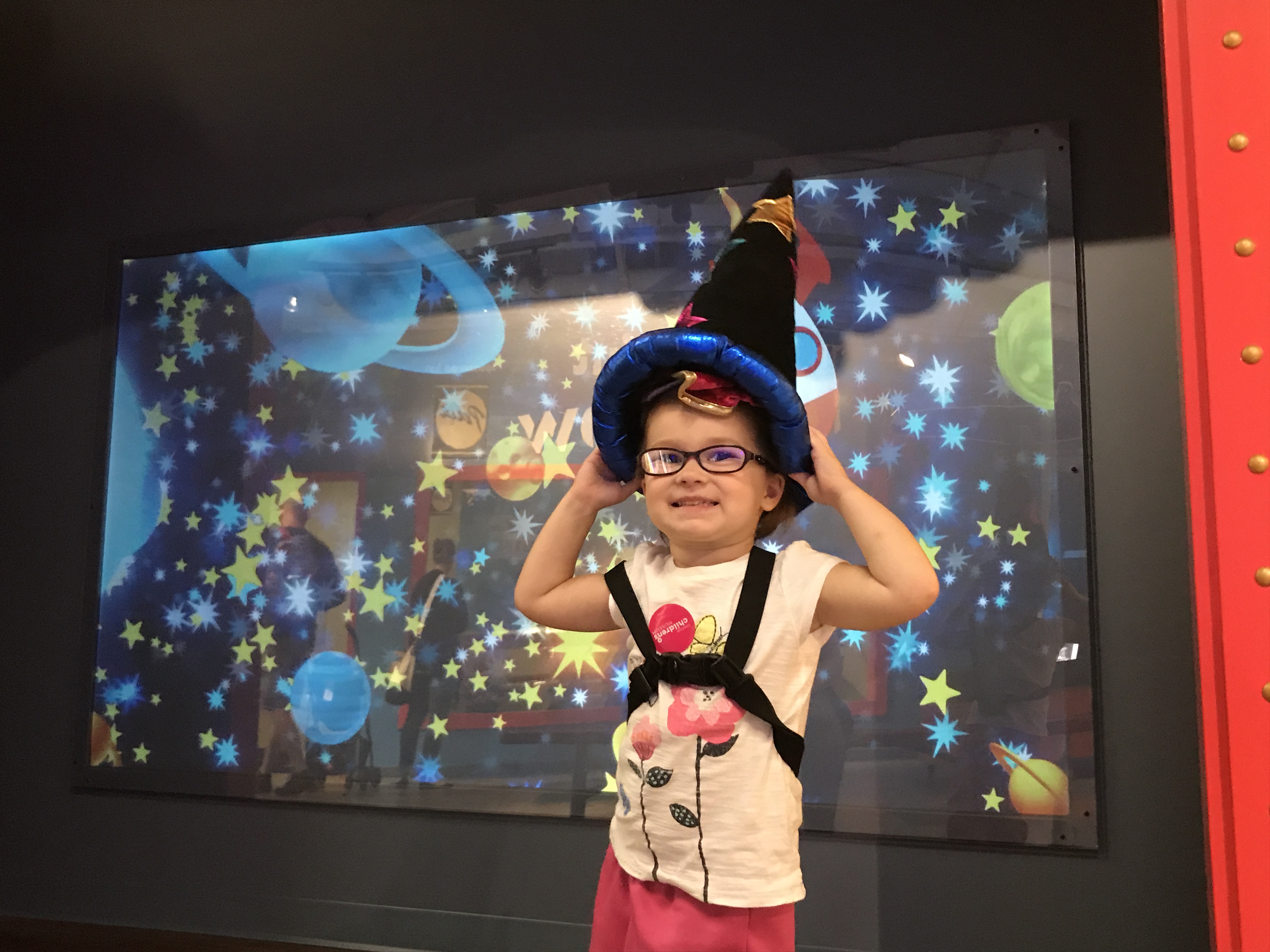April 14, 2023
The Importance of Creative Play
The mission of the Omaha Children’s Museum is to “Engage the Imagination and Create Excitement about Learning.” Perhaps one element of this statement that is often overlooked is that some of the most important learning children experience is actually through the imagination. In today’s society, there is a lot of emphasis placed on the importance of STEM-based learning. And that remains critically important. But by only focusing on Science, Technology, Engineering, and Math, children lose out on a pivotal piece of their development, that of creative play.

WHAT IS CREATIVE PLAY?
“Essentially, creative play includes activities that are not governed by rules. Creative play can include making or creating something new such as art or crafts, but it can also include dramatic play. Creating stories and writing can also be part of children’s creative playtime” (Guo, “The Importance of Creative Play”). Creative play can also encompass everything from drawing or painting, taking pictures, listening to or making music, and playing with or manipulating supplies such as clay, wire, wood, water, or light (PBS, “Creativity and Play: Fostering Creativity”). Creative play is also an excellent way to introduce multi-ethnic, multicultural, and other community experiences to your child. “The more varied experiences children have, the wider the range of creative expression. The more personal experiences children have with people and situations outside of their environment, the more material they can draw on to incorporate in their play” (PBS, “Creativity and Play: Fostering Creativity”).

WHY IS CREATIVE PLAY IMPORTANT?
Creative play is a safe way to encourage children to explore their choices and express themselves.
“According to early childhood researchers, pretend play, also called dramatic or creative play, is how children learn best. With creative play, children often imitate life such as playing ‘family,’ ‘school,’ or ‘restaurant.’ By reenacting these familiar situations in their play, Children get the opportunity to work on important soft skills such as conflict resolution, problem-solving, how to listen to instructions and develop their self-confidence. Developing these abilities are as significant to a child being kindergarten-ready and attaining success later in life as is focusing on literacy and numeracy” (Quality Care for Children, “Creative Play”). One of the clearest benefits of creative play is that it helps children work out some complicated emotions and find ways to express to adults what they are feeling and experiencing. Whether with other children or by themselves, creative play helps children express their emotions and cope with fears. Creative play with others can help develop important negotiating and communication skills as they work out the rules of a game or develop the narrative they are creating. While they may not realize it now, they are developing skills that will be incredibly helpful later in life as they navigate the workforce and the world around them. “Through dramatic play, children gradually learn to take each other’s needs into account and appreciate different values and perspectives” (PBS, “Creativity and Play: Fostering Creativity”). If playing on their own, children can use creative play to traverse through situations that might be causing them anxiety or fear. For example, perhaps you notice your little one pretending they are at a doctor’s office with their stuffed animal companion; by observing this interaction and listening to the dialogue you hear, you may discover that your child is nervous about an upcoming appointment you have, allowing you the opportunity to discuss these worries and alleviate that fear.
Additionally, creative play helps develop early literacy skills. Again, whether playing with other children or simply by themselves, by creating a dialogue, even with imaginary friends, your child is learning to utilize their vocabulary and build upon it.
Creative play is also imperative to developing important problem-solving skills. Perhaps your kiddo is imagining they are a firefighter needing to rescue a kitten from a tree. By dramatically acting this out, they will need to utilize the tools at their disposal to save their furry friend. What if the equipment needed isn’t available? They will have to work out another option to achieve their goals. These scenarios require them to analyze their choices (Guo, “The Importance of Creative Play”).

HOW CAN I ENCOURAGE CREATIVE PLAY?
Encouraging creative play for your kiddo is pretty simple. Just give them time and support to engage their imaginations. It is also helpful to provide some props for them to utilize. Don’t worry if the materials you have don’t fit exactly into the narratives they are creating.
Encouraging children to use materials in non-traditional ways is a fantastic way to stimulate creative play. And ask open-ended questions! “What do you think will happen next?” “Why do you think that happened?” “What if you did it this way instead?”
Looking for more great ideas to encourage creative play? Quality Care for Children provides a wonderful list of ways to encourage Creative Play based on age ranges:
BIRTH TO 1
- Incorporate music into your baby’s day. Try singing “Itsy Bitsy Spider” and “Wheels on the Bus” with the hand motions.
- Playing peek-a-boo with a blanket can send your baby into giggles
- Even your baby can play Follow the Leader. See if she can tap after you tab, wave her hand after you do, and so on.
- Pretend your baby is the pilot and you are the airplane. Lay your baby belly-down across your lap, and place your hands around his midsection so he’s fully supported. Then gently lift him up and move him up, down, back, and forth.
AGE 1 TO 2
- Create a costume trunk for your child that supports his interest in transportation and construction: police and firetruck outfits, plastic tools, and toolboxes
- Create some homemade instruments. Include saucepans, spoons, drums, bottles filled with rice, pasta, or sugar, and paper plates with metal curtain rings or bottle tops attached around the edge.
- Sure, finger painting can be messy, but it stimulates sensory development. Buy nontoxic paints and use old newspapers or any paper for your child to use for his creations.
- Your toddler loves to paint. How about doing some bathtub painting? You can find paints that are made for the tub and are easily cleaned up at your local store.
AGE 2 TO 3
- Does your childcare have plenty of supplies to encourage dramatic play? You can help keep it stocked by donating costumes and supplies.
- Make use of found and natural materials. On your next nature walk, collect leaves, small rocks, and other things you find to use in art projects.
- Has your child fallen in love with stamps yet? They can create stories with stamps or just have fun making different designs.
- On a pretty day, take your child and some bubbles outside. Chase them, catch them, pop them!
AGE 3 TO 4
- Keep a “busy box” filled with everyday objects: paper towel rolls, string, newspaper, cotton balls, etc. See what she can make!
- Have a dance party! Turn up one of your child’s favorite songs and take turns showing each other dance moves.
- Give your child a sorting treasure box. Donate a handful of your unwanted jewelry, glass stones, old keys…anything your child will consider a treasure, and let him sort it however he sees fit.
- The internet has lots of recipes for making homemade Play-Doh and slime. Half the fun is making it, and the other half is playing with it!
AGE 4 TO 5
- Encourage your child to act out his favorite books.
- Encourage your child’s artistic side. Create a home gallery for her artwork. Choose one painting to frame or hang up each week!
- Suggest “pretend” ideas: turn her room into a library and have her read aloud to her dolls.
- Turn your living room into the best fort ever with some sheets, pillows, and chairs (“Creative Play”).
Resources:
“Creative Play.” Quality Care for Children, 6 December 2017, https://www.qualitycareforchildren.org/gpp/2017/12/6/creative-play, 4 April 2023. “Creativity and Play: Fostering Creativity.” The Whole Child. PBS, https://www.pbs.org/wholechild/providers/play.html, 6 April 2023. Guo, Christina. “The Importance of Creative Play.” eLearning Industry, 2 September 2022, https://elearningindustry.com/the-importance-of-creative-play, 6 April 2023.


